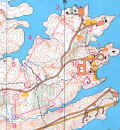|

|
 |
|

|
  
|
|
|
THE BASICS
The
goal of Orienteering is to find all of the check
points -- called controls -- in numerical order as
quickly as possible. Each control is identified with
a control bag, a code, and a paper punch, which is
used to verify your visit to the location.
In
order to orienteer, you'll need three things, which
we'll give you when you register:
|
|
|
|

|
| Orienteering
Map
Orienteering
maps are detailed topographical maps made by our club mappers
especially for our meets. When you register at our meets, we'll
give you a clean fresh map. Sometimes the course will already be
printed on the map, as in the following example, but other
times, you'll have to copy your course from a master map located
in the registration area.
|

|
|
click on image |
|
 |
| Control
Description
Control descriptions
tell you where your check points -- controls -- are located. We
typically use the international standard, which are the strange
looking symbols, but we always write out the symbol description
for beginners. (Hint: the symbols are described on the back of
your punch card.) |

|
|
click on image |
|
 |
| Punch Card
This is what you'll use to verify that you've
visited the correct location. Notice that the participant
has written the control description in each punch box. This
simplifies things when your out in the woods.
When you arrive at a
check point, you'll check the code on the clue to make sure it's
the right one you're looking for. Then you'll use the paper
punch hanging on the control to mark the correct square on your
punch card. |

|
|
click on image |
|
 |
| Control
Bag
Just in case you're
wondering what a control bag looks like, here is a rough sketch.
We usually hang these from trees or somehow attach them to the
feature. |
 |
|
Georgia
Orienteering Club - www.gaorienteering.org |